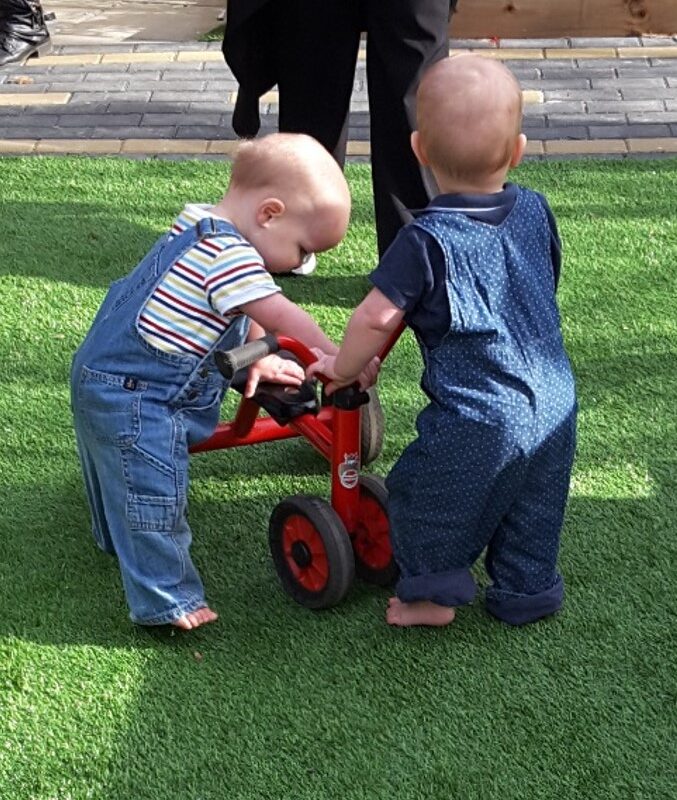
Hugh and Hamish, twin brothers, and their Mum, Sinead, arrived at South Acton Nursery School and Children’s Centre (SACC) when they were just 8 months old joining the Baby Hour group which I lead. My first encounter with the boys and their mum was the start of a longer relationship through which I observed and documented their development, learning and progress as it gathered momentum in quite different and unique ways. The boys were born just minutes apart, but my observations of their development showed their unique personalities, interests and the special relationship they had with each other.
Observation is woven throughout our practice at South Acton, a professionally informed skill which helps us to tune into our children’s development, play, language and interests. The Baby Hour Groups and Stay and Play sessions are an invaluable opportunity to observe the children’s play alongside their parents and talk together about what we see them doing and saying. Observing Hugh and Hamish at Stay and Play with their Mum, we would ‘watch, wait and wonder’ (Fisher, 2016) as their play unfolded, often taking photographs, and adding a short narrative, which became a learning story, explaining what the boys were doing and the meaning behind it. A learning story called “Trike and garden fun at Stay and Play!” captured Hugh and Hamish’s curiosity, play and exploration as they collaborated to find out more about the trike!
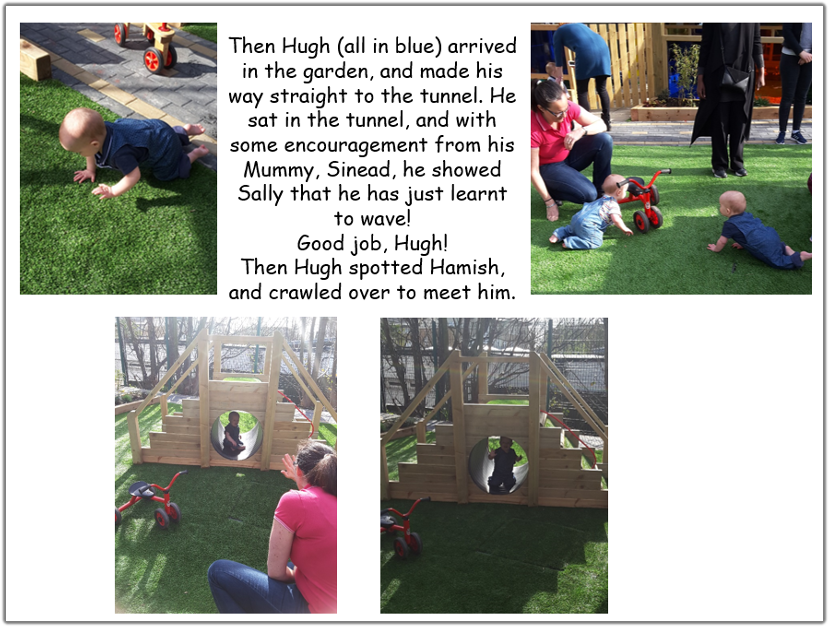
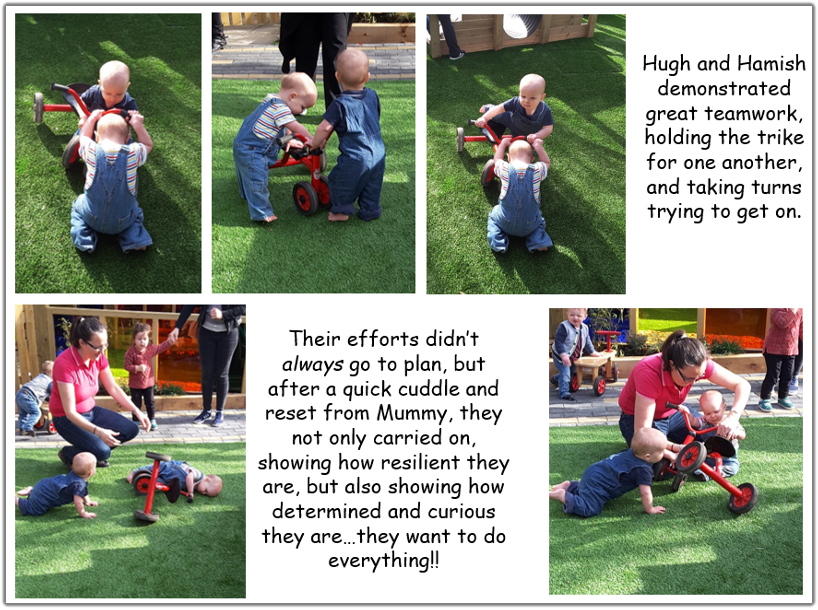
As the boys played Sinead and I watched, I took some photographs to capture their involvement and interactions and turned them into a short learning story which we shared with them. These narrative observations of the boys, at 16 months old, showed how they stuck very closely to one another, interacting between themselves and mum but as they felt more comfortable in their surroundings, they began to interact with other children more, even forming close friendships with two children, who they mixed with outside of the nursery. They explored together, and ‘allowed’ the two other children ‘in’, whilst sticking close to mum or dad.
The learning stories were invaluable as they show how intentional their playing and exploring is and make this much easier for parents to see, it’s not ‘just play’, it has a purpose showing their curiosity and interests. They enable us to talk about the children’s development in positive and reassuring ways (see Hugh’s Sandpit Investigation) especially when the boys needed help or wanted to do everything at once. Hugh and Hamish’s parents began to feel more confident and empowered as their knowledge and understanding of how the boys were developing and learning grew. I added their voices to the learning story,
Hugh and Hamish love coming to stay and play and it is wonderful to have a safe outdoor area where they can explore and develop new and emerging skills. They are so confident in the environment, which is amazing to see and testament to Sally, Elsa and all the staff that they encourage an atmosphere that is safe, nurturing and supportive to all parents, carers and children.
Thank you.
Parent's Voice
At a later stay and play session, when Hugh and Hamish were 26 months old, they were busy in the outside sandpit investigating a large bucket balance scale. Hamish was the instigator at the beginning of this exploration, but it was Hugh’s curiosity that led to some highly creative and critical thinking, as I observed with their Dad, we took a sequence of photographs to capture their investigations.

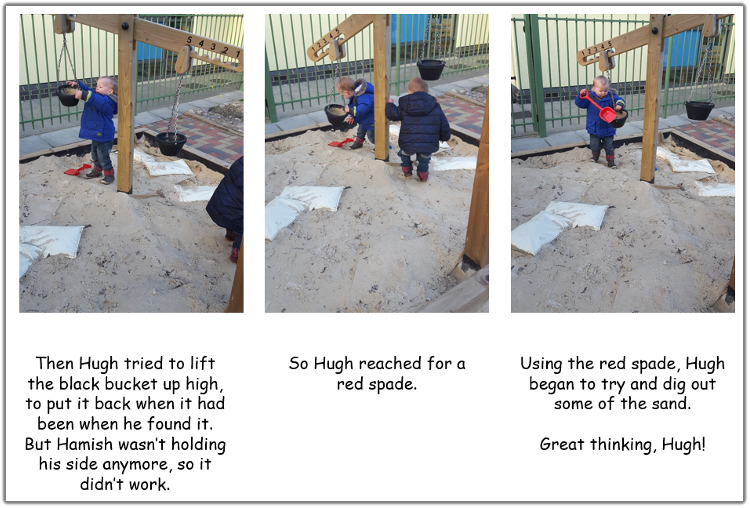
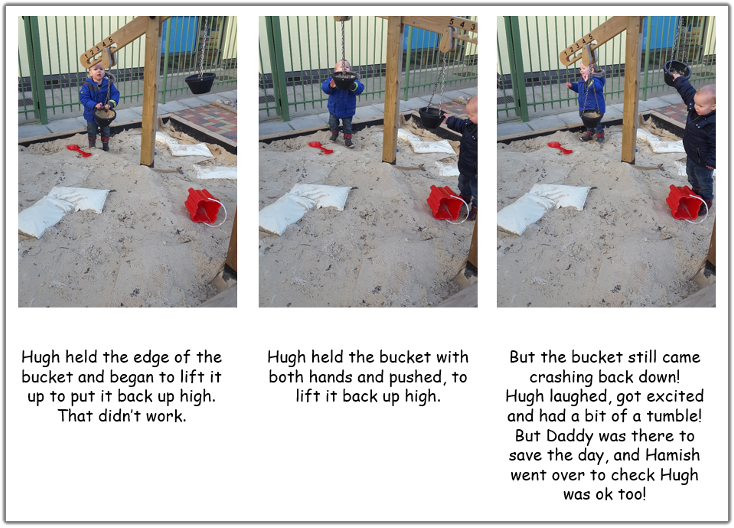
In my reflections of Hugh’s learning story I wrote the following,
In this story Hugh is focused on his investigation, I love how he tries to get the black bucket to rise up high again – not realising the only reason it was ever high was because Hamish held the other bucket down! It was a joy to watch Hugh investigate and try to find ways to make the bucket stay up, he had some big ideas, digging out the sand and holding it up. These are great theories to which we will return.
Hugh is motivated, inquisitive, impulsive and curious he always thinks outside of the box; he observes and investigates things that his peers don’t always, and although it keeps Mum and Dad on their toes, it really shows his level of understanding. I always know when you all appear that it will be an action-packed morning – and it always is.
The boys never stay still for long!
Sharing Hugh’s learning story with his Dad was quite emotional as he saw what Hugh was actually doing and how complex and deep his thinking was for a 26-month-old. Having worried about the boys lively, boisterous play ‘causing mayhem’ and ‘never focusing on anything or learning’ he said “he hadn’t seen that there was so much learning going on and the level of critical thinking, concentration, motivation and understanding involved! Everyone needs a Learning Story about their children, so they can see just how much they were learning through their play”.
I use the learning stories and my observations of Hugh and Hamish and talking with their Mum and Dad, to inform their Development Maps; as well as drawing on many other perspectives such as watching them play with their friends, seeing their different interests and listening to their communication and language.
The Development Maps show a unique holistic picture of the boys progress over a period of time, where we can see the relationship of one aspect of learning on another; where the boys are focusing their energies and importantly identify where they may need extra support. It gives parents a wonderfully clear overview of their child’s progress which is easy to understand as we talk through them together. Hugh and Hamish’s Mum and Dad really enjoyed seeing the boys development; they knew the boys were different, but they liked that it showed in their learning styles too, and reflected their ability at different ages, and that it allowed their personalities to shine through.
Looking at Hugh and Hamish’s Development Map it is helpful to keep in mind that they were not premature, Hugh is slightly older by 13 minutes. Also, that it is the ‘story’ underneath the map that brings it all to life for example being able to explain, to parents, why changes have occurred; perhaps speech has suddenly improved, so now we can see imaginative play developing too. Maybe the child’s confidence has grown, as they begin to walk and their world opens up, and they have been able to make friendships – as these often go hand in hand. We can see this in Hugh and Hamish’s Development Maps, particularly related to their physical development, being such avid explorers and problem solvers; also their interest in books, stories and singing at 16 mths old which has continued as their Mum described,
They both love reading and being read to, often seeing and commenting on different things. I remember when we read ‘Not Now Bernard’ and the ending when Hamish was adamant there was a monster, but Hugh said that it was just Bernard!
We quickly recognised the areas where the boys needed support. Speaking was progressing slowly though their understanding was well ahead, always a good sign. It had been difficult to engage a speech therapist, as the family were told it was often the case than twins were delayed in their speech, and that boys were often behind! But when we could evidence in such a striking yet simple way, through their maps, that some intervention was needed (especially as we could see what impact this was having on other aspects of their development) support was quickly put in place, though their language took some time to catch up.
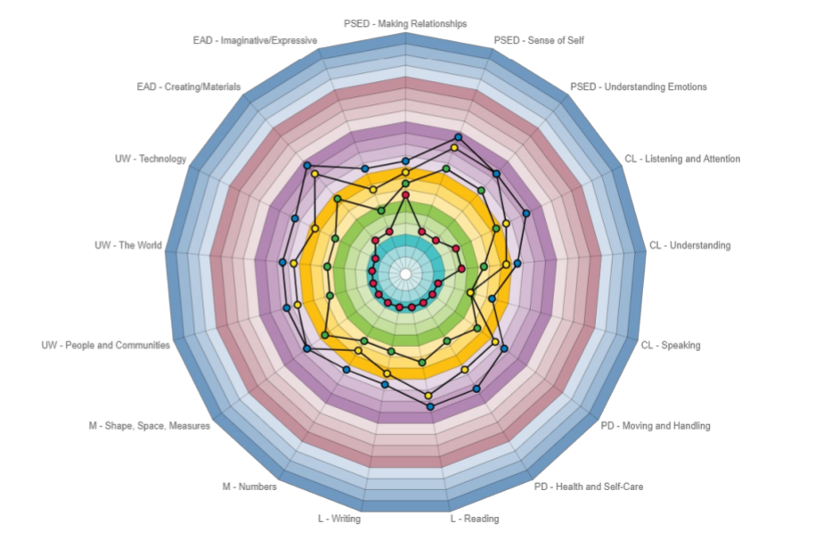

16 mths: Hamish is still settling into Stay and Play and Movers and Groovers getting used to the routines. He plays alongside others, using a familiar adult (his mum or dad) as a secure base from which to explore independently in new environments. Hamish is on the move now, which has helped his confidence and his exploration skills. His understanding and listening skills are growing too - he loves singing time which will help with his spoken language.
20 mths: Hamish's confidence is growing, as are his listening skills and understanding especially as he engages with stories and books – we can see this clearly in his Development Map; along with his interests in shape, space and measures and his creative play. Whilst Hamish’s communication is good his spoken language is slower than we would expect but the Talk and Play sessions will help to encourage conversations, especially with his brother.
24 mths: Although Hamish's development of spoken language has remained the same, he is communicating so well through his role play where he cooks dinner and tea; and through playing with small world scenarios especially the farm. Other areas of development have leapt over the last four months, and it's been a joy to see! He has developed a love of water play especially experimenting with capacity and becomes deeply involved in cooking activities and playdough maths.
28 mths: Hamish's speech is starting to take off and gather momentum after all the support and opportunities to listen to conversations he is now starting to be part of the conversation. He loves the Gruffalo, a recent Learning Story showed how well he concentrates and engages with the story, wanting to hear more, initiating his own ideas and enthusiastically following them. He has made a strong friendship with Adam and Hugh, they collaborate well together in their play, taking turns, being leaders and exploring together, this will all help to build his spoken language and conversational talk.


16 mths: Hugh enjoys singing and story time and gets excited by both – he listens really well. He is beginning to understand and follow simple sentence instructions and can let you know what he wants through pointing and eye gaze, though not yet through speech. He plays happily with his brother and likes mum to be close and he is beginning to show an interest in what other children are doing. His play shows real purpose and energy, especially when he is in the garden.
20 mths: Hugh’s physical development is really on the move now, this has helped his confidence and taken his exploration to a new level! Singing and story time are still a huge hit, and on occasion, Hugh will leave his mum or dad and join me at the front to sign – he loves sign of the week! Practicing Makaton at home is helping his communication – particularly listening and attention.Hugh's speech is still much slower than we would expect. We have spoken with a speech and language therapist who is arranging for him to join a Talk and Play course. I think this is having an impact on Hugh's imaginative play, we’re not seeing him in role play/pretend play, however his relationships with other children are consistent and strong.
24mths: Hugh's speech is beginning to develop now, as is his imaginative play. In the last four months, Hugh's brain has been busily developing he has leapt through so many stages here! The Talk and Play course has really supported his development. He is very interested in puzzles, blocks and weight particularly in his sand explorations.
28 mths: Hugh’s speech is steadily developing especially through his friendships with Hamish and Adam. His exploratory play where he is motivated, curious and always seeking a challenge shows how resilient he is. This is having an impact on his imaginative and collaborative play as well as many other aspects of his development, as we see his holistic development becoming more rounded. The focus is still on his language development, but I am sure we will see a rapid growth here in the months ahead.
The combination of using learning stories and shared observations (our formative assessment) and the Development Map (our summative assessment) is now an integral part of our Outreach Sessions and are used throughout the Nursery School and Children’s Centre. They have enabled our parents to see how their children’s involvement in play and exploration, underpins their learning and development, communication and language, making friendships and learning to co-operate, share and collaborate together. Significantly, as they observe and follow their children’s interests, they could see how big a part they played in their development and learning by becoming involved or by standing back and watching, taking some photographs and perhaps creating a learning story.
Hamish and Hugh moved to a new nursery which was closer to home, but their learning stories and Development Maps went with them, supporting their transition they gave the staff at the new nursery a greater insight into the boys development and progress, especially in speech and language which was just beginning to ‘’take off’. They could also see the boy’s unique personalities, interests, motivation and collaborative relationships. At home, Hugh and Hamish’s learning stories are still on the bookshelf with all their other books; they read them often along with their older sister it is a real family affair!
Fisher. J (2016) Interacting or Interfering? Improving interactions in the early years, Open University Press
The Development Map https://developmentmap.co.uk/ and https://www.facebook.com/Thedevelopmentmap